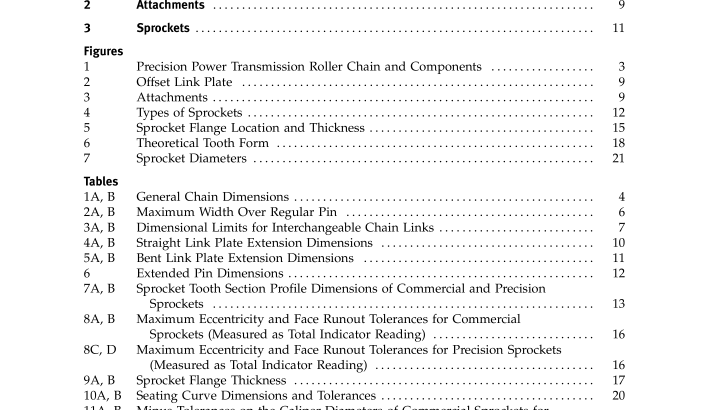ASME B29.1-2002 pdf free download.PRECISION POWER TRANSMISSION ROLLER CHAINS, ATTACHMENTS, AND SPROCKETS
1.3 Numbering System —Standard Chain Numbers
For the chains shown in this Standard, the right-hand digit in the chain designation is zero for roller chains of the usual proportions, 1 for a lightweight chain, and 5 for a rollerless bushing chain. The numbers to the left of the right-hand digit denote the number of 1 ⁄ 8 in. in the pitch. The letter H following the chain number denotes the heavy series. The hyphenated number 2 suffixed to the chain number denotes a double strand; 3, a triple strand; 4, a quadruple strand chain; etc. Heavy series chains made in 3 ⁄ 4 in. (19.05 mm) and larger pitches differ from the standard series in thickness of link plates. Their value is only in the acceptance of higher loads during operation at lower speeds.
1.4 Chain Strength Requirements
1.4.1 Minimum Ultimate Tensile Strength
(a) Single Strand Chain. Standard series single strand chains meeting the requirements of this Standard will have a minimum ultimate tensile strength equal to or greater than the values listed in Table 1A or 1B.
(b) Multiple Strand Chain. For multiple strand chain, the minimum ultimate tensile strength equals that of a single strand multiplied by the number of strands.
(c) Lightweight Chain. Lightweight chain designated as No. 41 does not conform to the general chain propor- tions. The minimum ultimate tensile strength is 1500 lb (6.67 kN).
(d) Minimum Ultimate Tensile Strength (M.U.T.S) for chain covered by this Standard is the minimum force at which an unused, undamaged chain could fail when subjected to a single tensile loading test.
WARNING: The minimum ultimate tensile strength is NOT a “working load.”The M.U.T.S. greatlyexceeds themaximumforce that may be applied to the chain.
(1) Test Procedure. A tensile force is slowly applied at a rate not to exceed 2.0 in./min (50.8 mm/min), in a uniaxial direction, to the ends of the chain sample.
(2) The Tensile Test Is a Destructive Test. Even though the chain may not visibly fail when subjected to the minimum tensile force, it will have been damaged and will be unfit for service.
1.4.2 Minimum Dynamic Strength (a) Application. Onlysingle strandstandard and heavy series chains are subject to the minimum dynamic strength requirement. Multiple strand chains, attachment chains, connecting links, and offset links are not subject to the minimum dynamic strength requirement.
(b) Conformance. The chain shall survive a confor- mance test at the load listed for the subject chain in Table 1A or 1B. WARNING: The dynamic testvalues are notvalid characteristics fordesigning actual applications. Neither the specified value nor the test results are to be interpreted as allowable working loads.
(c) Test Procedure. The chain shall be tested according to the conformance test described in ASME B29.26-2001.
1.7 General Chain Dimensions
See Tables 1A and 1B.
1.8 Maximum Chain Dimensions
See Tables 2A and 2B.
1.9 Dimensional Limits for Interchangeability of Links
See Tables 3A and 3B. To assure interchangeability of links produced by different makers of chain, the follow- ing standard maximum and minimum limits are adopted.
a) Minimum distance between roller link plates is the nominal width ofthe chain minus the quantity (0.002 + 0.003 ? pitch). (b) Maximum pin diameter: see Tables 3A and 3B. (c) Minimum hole in bushing: see Tables 3A and 3B. (d) Maximum width of roller link p nominal width of chain + (2.12 ? nominal link plate thickness). (e) Minimum distance between pin link plates p maximum width of roller link + 0.002 in. (f) Nominal transverse pitch of multiple strand chain p nominal width of chain + (4.22 ? nominal link plate thickness).ASME B29.1 pdf download.ASME B29.1-2002 pdf free download
